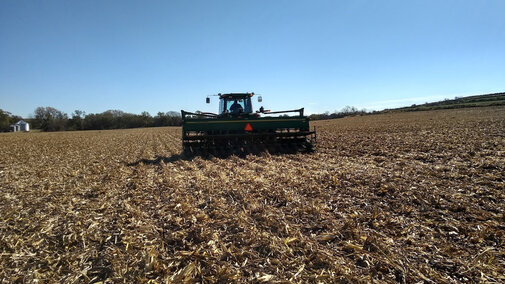Between spring thaw and soybean planting, the risk of soil nitrogen (N) loss is great. As soil temperatures warm, soil microbes become active and start decomposing organic matter. Nitrogen released during decomposition is vulnerable to leaching as nitrate. Having a crop in the ground that can take up nitrate in early spring reduces the risk of significant leaching. Cereal rye is well suited as an N scavenger. The most winterhardy small grain, it starts growing at temperatures as low as 32°F and can be a prolific biomass producer with an extensive, fibrous root system.
In trials conducted at three research stations in eastern, northeastern and south-central Nebraska, we investigated rye productivity and its ability to scavenge N when grown as a cover crop between full-season corn and soybeans. Rye cover crops planted after corn in late October to late November and terminated in late April to early May produced at least 1,000 lb/ac of dry matter in half of the site years. Rye contained about 3% N in its aboveground dry matter. We did not measure root dry matter, but assume that root dry matter is similar to aboveground dry matter and contains 1% N. Thus, for a rye cover crop with 1,000 lb of aboveground dry matter, total N content (aboveground and belowground) can be estimated at about 40 lb/ac.
Even with this moderate rye N uptake, we were able to detect differences in spring soil nitrate in the upper 8 inches of the soil. Under rye, soil nitrate was significantly lower than under the control (no rye) in most site years. Where soil temperatures are warmer, such as in our south-central location, rye plots had 20 ppm less soil nitrate than control plots.
While the ideal planting time for rye is coming to an end, growers interested in using rye as an N scavenger can still plant it. Even with modest growth, rye N uptake can be expected to reduce soil N leaching losses.
Reference
Sievers, T., and R.L. Cook. 2018. Aboveground and Root Decomposition of Cereal Rye and Hairy Vetch Cover Crops. Soil Science Society of America Journal 82(1): 147. doi: 10.2136/sssaj2017.05.0139.

